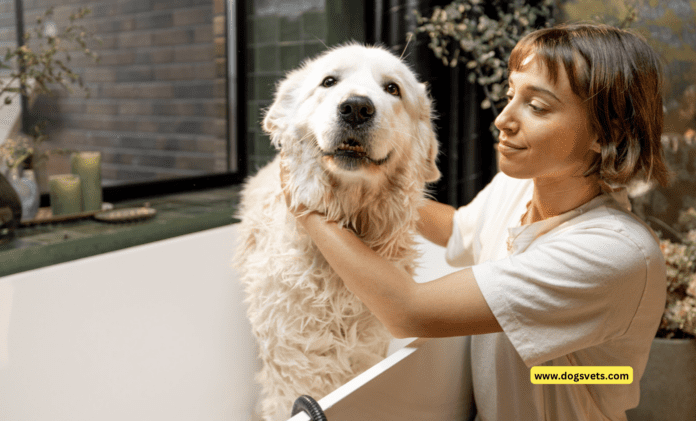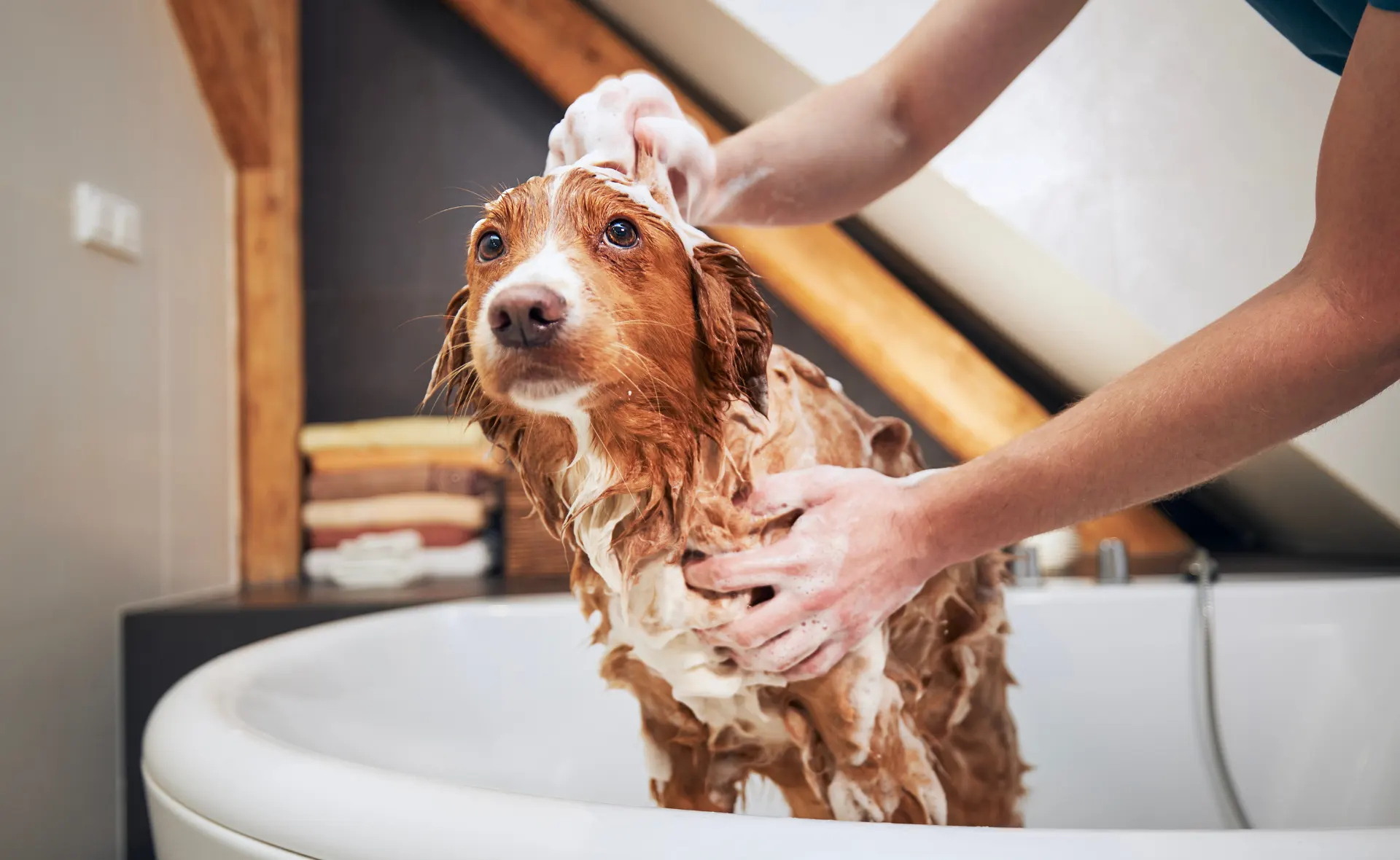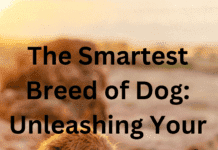Last Updated on November 3, 2023 by Dogs Vets
How to Properly Wash a Dog’s Paws
Nearly every dog owner encounters the issue of dirty paws after a walk. It’s important to note that not all of our four-legged friends enjoy taking baths.
Maintaining paws after each walk can be quite challenging, especially for larger or giant breeds.
Why and how should you care for your pet after a stroll outside? And most importantly, how do you properly wash a dog’s paws post-walk?
It’s easier to handle a smaller dog; you can effortlessly carry them to the bathtub. But what if your furry companion is too big to lift? Or if the animal has a panic-inducing fear of water, turning its bath time into a deluge?
Let’s address these questions.
Why wash a dog’s paws after every walk?
To maintain the cleanliness of their apartment, many dog owners start washing their pet’s paws exclusively during spring or autumn when the outdoors gets muddy.
However, washing paws is essential not just for keeping the living space clean. So, why should you clean their claws and toes from contaminants in every season?
- Washing paws helps to remove harmful substances, such as petroleum products or other toxins, that might have accidentally gotten onto the pet’s feet. Their presence could lead to pet poisoning or other severe health consequences.
- Cleaning paws in the winter, when streets are treated with de-icing chemicals, prevents irritation and allergies.
- Timely hygiene practices allow you to detect any skin damage after outdoor walks.
- Treating injuries at an early stage is much easier than addressing more advanced cases.
- Washing paws after being outside helps safeguard both the dog and humans from bringing infections and various parasites indoors, many of which can be very dangerous.
- Of course, without clean dog paws, you can forget about maintaining the cleanliness of floors, carpets, furniture, and clothing.
What products can be used to wash a dog’s paws?
Many dog owners use dog shoes or boots as a protective measure. However, not every pet will allow boots or rubber socks to be put on its paws, and these cannot address the issue of a dirty tail or belly.
For daily hygiene, various products can be used, such as:
Dog shampoos. It’s important to note that these shampoos won’t eliminate ticks or bacteria.
Shampoos with chlorhexidine. The antiseptic component in these shampoos can help treat inflammation caused by minor injuries to the paw pads. Before using, it’s recommended to consult with a veterinarian.
Hypoallergenic shampoos. These are suitable for dogs with increased sensitivity.
Shampoos with tar soap. While tar soap, which has antiseptic and anti-parasitic properties, is considered a budget-friendly hygiene option, its isolated use can lead to excessive skin dryness, which can cause cracks. A better approach would be to combine the shampoo with tar soap.
Shampoos containing panthenol – a substance used for wound healing and reducing inflammation.
There are also specialized shampoos for heavily soiled paws. They help clean off asphalt, engine oil, salt, while providing gentle care.
Paw soap. It comes in both solid and liquid forms. Choose the one that’s more convenient for you to use.
Wet wipes. It’s preferable if they’re saturated with moisturizing and antiseptic solutions. They are particularly useful during dry periods.
How to Properly Wash a Dog’s Paws After a Walk
For post-walk hygiene procedures, options include using a bathtub, basin, washing under a faucet, or a specialized paw washer. Each owner chooses their preferred method of cleaning paws based on their own capabilities, the size of the pet, and the level of its training.
To make washing more comfortable, it’s essential to follow certain rules:
- Maintain a proper water temperature. There shouldn’t be significant temperature differences between the outdoors and the water. After winter walks, the water should be cool, not hot!
- Use a sponge. It’s soft and helps to lather the shampoo well.
- Have dry, clean towels on hand, preferably made of microfiber.
- Always inspect the paws for any injuries.
- Wash in sequence: first wash the front paws in water, place them on a towel, and then proceed with the hind paws.
- If areas other than the paws are dirty, it’s best to wash the dog in a bathtub.
- Additional useful items for washing paws in the hallway include a rubber mat, a basin or tray, a pitcher with a spout, a bucket of water, and a low stool (so the owner can see without having to bend over).
An Alternative from Pet Product Manufacturers – The Paw Washer. Specialized containers designed for various dogs have appeared on the market, aiming to simplify the paw washing process. They are called “paw washers.”
Inside the container are silicone brushes, and once it’s filled with water and shampoo, the paw is dipped inside. The washing is quick and straightforward.
Recommendations for Acclimating Your Dog to Paw Washing
For many pets, the process of paw washing is an unpleasant one. Sometimes, anticipating the regular “ordeal,” a pet might even resist returning home.
For owners, the constant struggle with a dog refusing to undergo water procedures is hardly enjoyable. To make paw washing a pleasant ritual, it requires the owner’s patience and a well-trained dog. The following recommendations can help minimize stress during this process:
- Acclimate your pet to paw washing from a young age.
- Introduce your dog to water and water-based procedures gradually.
- A puppy will adapt faster if its paws are wiped with a towel, followed by a reward in the form of kind words and a treat. This way, the touches become familiar to them.
- Using a non-slip mat in the bathtub can help prevent falls and reduce the dog’s fears.
- Initially, washing should be brief and enjoyable.
- In the beginning, it might be helpful to leash your dog to ensure it doesn’t run away prematurely.
Training a dog should be consistent: the post-walk routine should be followed precisely every time. Every positive behavior should receive emotional reinforcement.
The end of the hygiene procedure and “release” can come after the command “go play,” once the dog has had a chance to shake off thoroughly.
Otherwise, the pet (if not only the paws but also other body parts were washed) will inevitably shake off in an inappropriate spot – close to white wallpaper, for example.
Timely training of a dog to wash its paws after walks will prevent stressful situations in its adult age. This ensures not only a clean floor, furniture, and entire apartment but also maintains the pet’s health for a long time.
If, during the paw washing, you notice redness, cracks, ulcers on the skin or the pads, it’s advisable to consult a veterinary dermatologist. The doctor will help determine the cause of the damage, prescribe treatment, and recommend appropriate care for your pet’s paws.

















